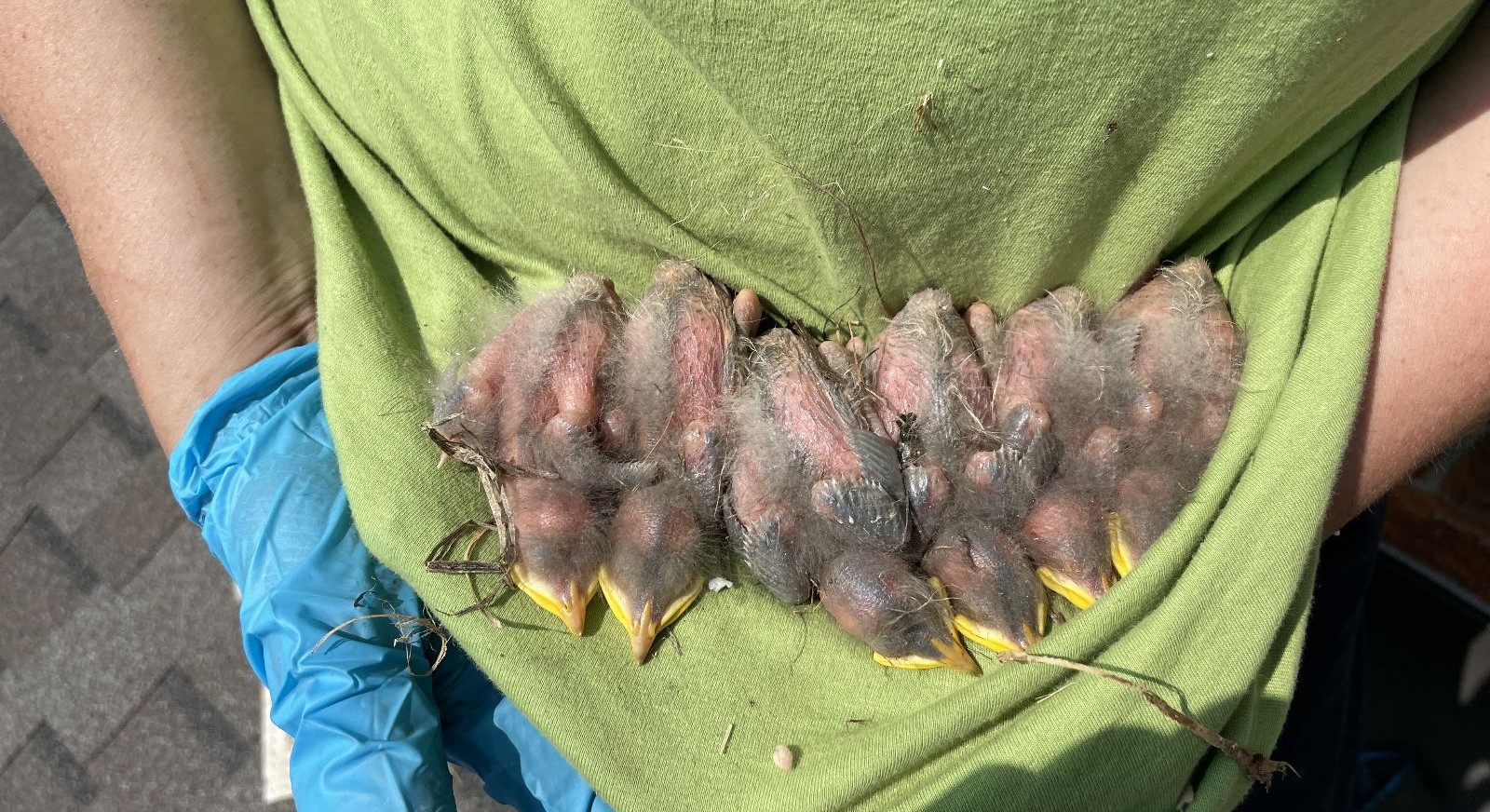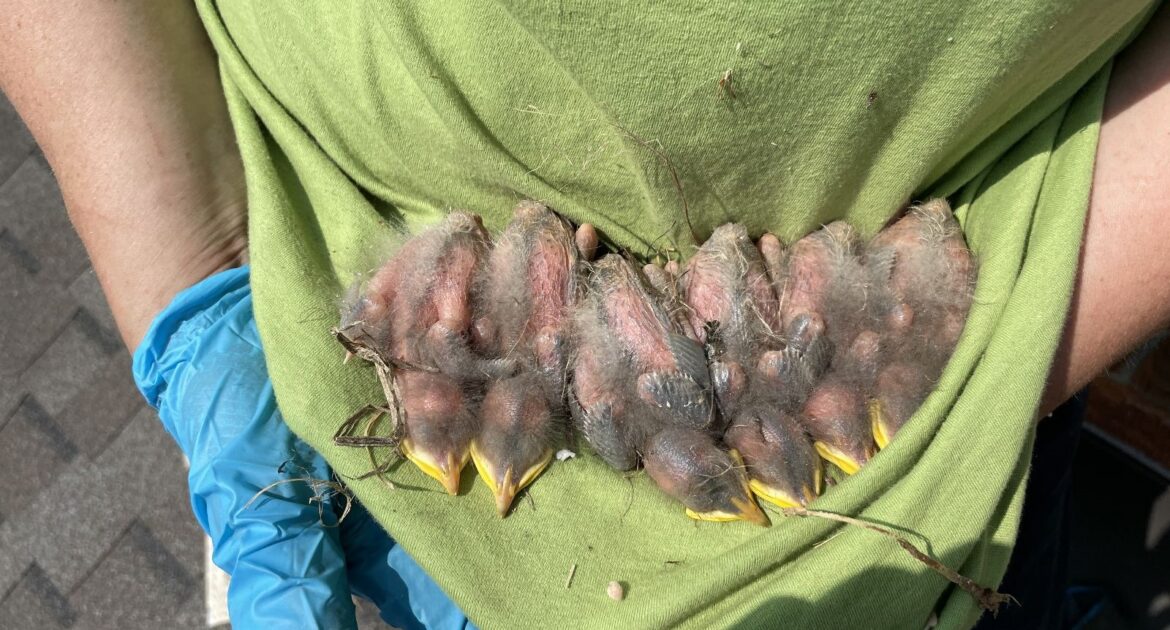Hearing chirping coming from your chimney or vents? It’s likely birds have built a nest inside your home. Birds love warm, sheltered spots like chimneys, attics, and vents to raise their young. But while it might seem harmless, nesting birds can cause serious problems—blocking chimneys, creating fire hazards, spreading bacteria, and even causing structural damage.
Dealing with nesting birds quickly and safely is crucial. This guide will help you recognize the signs of bird activity, understand the risks they pose, and give you practical tips to manage and prevent bird nests in your home. At Skedaddle Humane Wildlife Control in Montreal, we’ve seen just how much damage bird nests can cause if left unchecked.
Learn how to protect your home, safeguard your family, and keep wildlife out—humanely and effectively!
Signs That Birds Are Nesting in Your Chimney or Home
Wondering if you have birds nesting in your home? Here are the telltale signs to look out for.
- Chirping and Flapping Noises: A constant stream of chirping, especially in the morning, could mean baby birds are nearby. Flapping sounds are also a common clue that adults are flying in and out of the nest to bring food. If these noises are coming from your chimney, you likely have nesting activity.
- More Birds Around Your Roof: Increased bird activity, like them repeatedly flying to and from your roof or chimney, often means they’re carrying nesting material or food back to their young.
- Nesting Materials: If you notice twigs, leaves, or feathers near vents, chimneys, or gutters, it’s a major red flag. Birds gather these materials to build their nests and might leave pieces scattered around the entry points to their new home.
- Foul Smells: A build-up of droppings or old nesting materials can create a strong, musty odour. This unpleasant smell near your chimney or vents is another clue of nesting birds.
- Poor Ventilation: If your chimney or vent isn’t working as well as it should, a bird’s nest could be to blame. Nests can block airflow, making it harder for smoke or odours to escape your home.
If you spot any of these signs, it’s time to act. Addressing nesting activity early can prevent more serious problems.
Common Birds That Nest in Chimneys
Some types of birds are more likely to nest in chimneys and other parts of your home. Here are the most common ones to watch for.
- Chimney Swifts: These birds are small, dark, and incredibly agile fliers. They cling to chimney walls and make sharp, high-pitched sounds. Chimney swifts build their nests out of twigs, held together with their saliva.
- Starlings: Known for their adaptability, starlings will nest in chimneys, vents, and even eaves. Starlings are noisy, often chattering loudly near their nests.
- Sparrows: These tiny birds build compact nests in protected spaces like dryer vents or under roof overhangs. Sparrows are very common and can bring plenty of nesting materials into your chimney or vents.
- Pigeons: Pigeons often nest in attics or roof spaces rather than chimneys, but their presence is still a concern. They leave behind significant amounts of droppings and debris, which can cause health and structural problems.
While each bird has unique nesting habits, they all pose risks when they settle inside your home. Recognizing the type of bird can help you better understand the situation and how to handle it.
The Risks of Nesting in Your Home
At first glance, having birds nest in your home might not seem like a big deal. But their nesting habits can actually lead to serious risks for your house and your family. From fire hazards to health concerns, it’s important to understand why addressing nests quickly matters.
One major concern is the risk of fire. Birds often use dry materials like twigs, leaves, and feathers to build their nests. If a fireplace is lit while birds are nesting in the chimney, those materials can easily catch fire, creating a dangerous situation inside your home.
Structural damage is another issue to watch for. Birds can clog vents with debris, tear apart insulation, and make small gaps bigger as they come and go. These gaps could even allow other wildlife to slip into your home unexpectedly, causing additional damage over time.
Health concerns are a less obvious but serious risk. Droppings can carry bacteria, fungi, and even parasites that are harmful to humans and pets. For example, inhaling spores from droppings can cause respiratory problems. Keeping your home free of nests helps minimize these potential health risks.
Blocked ventilation is yet another problem that nests can create. When birds build nests in dryer or stove vents, airflow gets restricted, which could lead to dangerous issues like carbon monoxide buildup. This makes addressing nests in vents especially critical for the safety of your household.
How to Identify an Active Nest vs. an Abandoned One
If you’ve noticed nesting in or around your home, the first step is figuring out if the nest is still in use. Knowing whether a nest is active or abandoned helps you handle the situation safely and appropriately. Removing an active nest without proper care can harm the birds and leave problems unresolved, while abandoned nests can still cause blockages or damage if left in place.
Signs of an Active Nest
Active nests will show clear signs of bird activity. For starters, watch for flying near the chimney or vent frequently. If they’re coming and going throughout the day, it’s likely they’re feeding chicks or bringing in extra materials to maintain the nest.
You might also hear sounds from inside your home. Chirping or rustling noises often come from baby birds calling for food or the parent birds making adjustments. These sounds are a strong sign that the nest is occupied.
Another indicator is the presence of droppings or nesting materials near the entry point. Feathers, twigs, or pieces of grass around vents or chimneys mean there’s likely some recent nesting activity taking place.
Signs of an Abandoned Nest
An abandoned nest will appear quiet and untouched. One of the first things to notice is a lack of bird activity. If you haven’t seen any birds flying near the chimney or vent for several days, the nest may no longer be in use.
You’ll also notice an absence of fresh droppings or new materials around the area. Without regular activity, the space around the nest stays cleaner than it would with an active brood of birds.
The nest itself might look different, too. An abandoned nest tends to lose its structure over time and can appear flattened or even slightly damaged as it goes unused.
Home Bird Management: Preventing Future Nesting Problems
Birds nesting in your home can lead to a range of problems, from blocked vents and damaged insulation to potential health risks. Taking simple preventative steps now can save you from costly repairs and help you peacefully coexist with wildlife.
- Install a chimney cap to block birds from entering your chimney while maintaining proper airflow.
- Seal gaps around vents, soffits, and eaves with durable materials to eliminate easy access points.
- Inspect your roof and chimney once or twice a year to catch and address early signs of bird activity.
- Use humane deterrents like reflective tape or wind-activated decoys to discourage birds from settling nearby.
By taking these proactive measures, you can protect your home from the damage caused by nesting birds while ensuring they find safer, more appropriate places to live. A little effort goes a long way in keeping your home safe and bird-free.
Say Goodbye to Nesting Birds Safely
If you think birds may have built a nest in your chimney or vents, it’s important to act fast. Waiting can lead to damage, safety risks, and even health concerns. While trying to fix the problem yourself might seem like an easy solution, professional help is the best way to ensure the birds are removed safely and humanely.
At Skedaddle Humane Wildlife Control, we specialize in humane bird removal. Our one-way doors allow birds to leave without the chance to come back. This effective approach keeps your home secure and bird-free.
With our experience in identifying chimney birds and providing reliable home bird management, we’ll not only solve the issue but also help prevent it from happening again.
Don’t wait to take action. Contact us today to request a quote or learn more about how we can help. With our services, you’ll keep your home safe and enjoy peace of mind knowing the problem is handled the right way.




